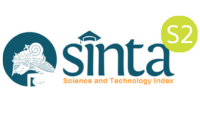SURAKARTA BERGERAK (REKONSTRUKSI SEJARAH PERGERAKAN DI SURAKARTA AWAL ABAD KE-20)
DOI:
https://doi.org/10.31330/penamas.v31i2.231Keywords:
movement, natives people, colonialismAbstract
ABSTRACT
This research is the result of a historical research, which aims to reconstruct the emergence and growth of movement in Surakarta in colonial period. This study answers the questions of dynamics and movement in Surakarta, which include: (1) background factors of the dynamics and movement in Surakarta in colonial period, and (2) the form of dynamics and movement. The method used in this study is historical method, which consists of four stages, namely heuristic, source criticism, interpretation, and historiography. The historical paradigm used is that of John Tosh, i.e. to reconstruct history by understanding the social background and circumstances that cause the development of an event, and the direction of its changes. As for the reconstruction of the past, this study uses the model of the central circle. In this model, it is assumed that the incident at the center of the circle will have consequences in the vicinity. In turn, the center of the circle and the surrounding areas will lead to a new center around which will also result in new symptoms. The theory used is the theory of conflict, social movements, and resistance ideology. The use of the social theories is important for the study of history to expand in space (synchronous), in addition to remaining in the basic ground pattern of history that extends in time (diachronic). This study found historical facts that, in a piece of history of the movement in Indonesia, there are various factors and form of the dynamics of movement in Surakarta at colonial period. Dynamics and movement in Surakarta motivated by external factors (pressure from Western imperialism) and internal one (increasing struggle of indigenous organizations and modern media). The form of dynamics and movement in Surakarta are central circular, complex and interrelated in various fields, namely social and cultural sectors, agrarian, economic, political and religion. The results of this research have contributed knowledge to the discipline of history, especially in the exposure and reconstruction of a history fragment of the dynamics and movement of natives (indigenous people) in the revolt imperialism. In addition, the role of religion movement in forming a moving situation is found in this study. It indicates that this research can also contribute to the discipline of History of Islamic Culture.
References
Amir, Muhammad, Riwayat Berdirinya Muhammadiyah di Surakarta, Surakarta: Sekretariat PDM, t.t.
Abdullah, Taufiq (ed.), Sejarah Umat Islam Indonesia, Jakarta: Majelis Ulama Indonesia, 1991.
Adnan, Basit, Sejarah Masjid Agung dan Gamelan Sekaten di Surakarta, Sala: Mardikintoro, 1996.
Bakri, Syamsul, Gerakan Komunisme Islam Surakarta 1914-1942 (Yogyakarta: LKiS, 2015).
Baudet, Enrest Henri Philippe dan Izaak Johannes Brugmans, Politik Etis dan Revolusi Kemerdekaan, terj. Amin S., Jakarta: Yayasan Obor Indonesia, 1987.
Benda, Harry J., The Crescent and the Rising Sun, The Hague & Bandung: Van Hoeve, 1958.
Bratakesawa, Raden, Katrangan Tjandrasangkala, Djakarta: Balai Pustaka, 1952.
Cassanova, Jose, Public Religion in the Moderen World, Chicago: The University of Chicago Press, 1994.
Coser, Lewis, The Function of Social Conflict, New York: The Free Press, 1956.
Couperus, Louis, Unter Javas Tropensonne, Berlin: Deutsche Buch-Gemeinschaft, 1926.
Dahrendorf, Ralf, Class and Conflict in Industrial Society, Stanford: Stanford University Press, 1959.
Eyerman, Ron & Andrew Jamison, Social Movements: a Cognitive Approach, Pennsylvania: Pennsylvania State University Press, 1991.
Federspiel, Howard M., Indonesian Muslim Intellectuals of the 20th Century, Singapore: ISEAS Publications, 2006.
Florida, Nancy K., Writing the Past, Inscribing the Future: History as Prophesy in Colonial Java, North Carolina: Duke University Press, 1995.
Graaf, H.J. de, Risalah Sejarah dan Budaya: Het Kadjoran Vraagstuk (Masalah Kajoran), terj. Suwandi, Yogyakarta: Balai Penelitian Sejarah dan Budaya Pusat Penelitian dan Budaya Depdikbud, 1980.
Habsjah, Attashendartini, et al. (eds.), Perjalanan Panjang Anak Bumi, Jakarta: Yayasan Obor Indonesia, 2007.
Hadisiswaja, Asnawi, Soerakarta Adiningrat, Soerakarta: Uitg Poesaka Soerakarta & Islam Raja Solo, 1936.
Hardjosoewito, Endro, Pantjang Sedjarah Indonesia, Djakarta: Pustaka Energi, 1953.
Hatta, Mohammad, Kumpulan Karangan I, Djakarta-Amsterdam-Surabaja: Balai Buku Indonesia, 1953.
Hering, B.B., Soekarno: Founding Father on Indonesia, 1901-1945, Michigan: KITLV, 2002.
Hoedijono, “Awas! Kaoem Boeroeh Hindia!â€, dalam Ra’jat Bergerak, 18 Oktober 1923.
Hurgronje, Snouck, “Sarekat Islamâ€, dalam E Gobee dan C. Adriaanse, Nasihat-nasihat C. Snouck Hurgronje Semasa Kepegawaiannya kepada Pemerintah Hindia Belanda 1889-1936, terj. Sukarsi, Jakarta: INIS, 1995.
Ibrahim, Julianto, Bandit dan Pejuang di Simpang Bengawan: Kriminalitas dan Kekerasan Masa Revolusi di Surakarta, Wonogiri: Bina Citra Pustaka, 2004.
Isma’il, Ibnu Qoyim, Kiai Penghulu Jawa: Peranannya di Masa Kolonial, Jakarta: Gema Insani Press, 1997.
Kahin, George McTurnan, Nationalism and Revolution in Indonesia, New York: Cornell University, 1952.
Kartodirdjo, Sartono, et al., Sejarah Nasional Indonesia, Jilid III, Jakarta: Departemen Pendidikan dan Kebudayaan, 1975.
Korver, Ape, Sarekat Islam, Gerakan Ratu Adil?, terj. Tim Grafiti, Jakarta: Grafiti Press, 1985.
Kwantes, R.C., De Ontwikkeling van de Nationalistische Beweging in Nederlandsch-Indie, Groningen: H.D. Tjeenk Willink, 1975.
Laffan, Michael Francis, Islamic Nationhood and Colonial Indonesia: the Umma below the Winds, London & New York: Routledge Curzon, 2003.
Larson, George D., Prelude to Revolution: Palaces and Politics in Surakarta 1912-1942, Holland & USA: Foris Publication, 1987.
Latif, Yudi, Inteligensia Muslim dan Kuasa: Geneologi Inteligensia Muslim Indonesia Abad Ke-20, Bandung: Mizan, 2005.
Leur, C.J. Van, Indonesian Trade and Society, Bandung: Sumur Bandung, 1960.
Lombard, Denys, Nusa Jawa Silang Budaya: Warisan Kerajaan-Kerajaan Konsentris, terj. Tim Gramedia, Jilid 3, Jakarta: Gramedia, 1996.
Margana, S., Kraton Surakarta dan Yogyakarta 1769-1874, Yogyakarta: Pustaka Pelajar, 2004.
Materu, Mohamad Sidky Daeng, Sedjarah Pergerakan Nasional Indonesia, Djakarta: t.p., 1970.
Meidema, J. dan Stokhof, Memories van Overgave van de Afdeling Noord Nieuw-Guinea, Leiden: DSALCUL, 1991.
Mirjam Maters, Van Zachte Wenk Tot Harde Hand: Persvrijheid en Persbreidel in Nederlands-Indië, 1906-1942, Dutch: Hilversum Verloren, 1998.
Mooryati, Soedibyo dan Sumoningrat Gunawan, Sri Susuhunan Paku Buwono X: Perjuangan, Jasa, dan Pengabdian untuk Nusa dan Bangsa, Jakarta: Bangun Bangsa, 2009.
Marcopolo, The Travel of Marco Polo, revised from Marsden’s, Translation and edited with introduction by Manuel Komproff, New York: W. W. Norton & Company Inc., 1930.
Neil, Robert van, The Emergence of Modern Indoenesian, The Hague and Bandung: Van Hoeve, 1956.
Nurhayati, Dwi Ratna et al., Sejarah Kerajaan Tradisional Surakarta, Jakarta: Departemen Pendidikan & Kebudayaan Republik Indonesia, 1999.
Pimpinan Pusat Muhamamdijah, Suara Muhammadijah (Mendjelang Peringatan 40 Tahun Muhammdijah), Edisi 27, November 1953.
Pranoto, Suhartono W., Jawa: Bandit-bandit Pedesaan, Studi Historis 1850-1942, Yogyakarta: Graha Ilmu, 2010.
Pringgodigdo, Abdul Karim, Sedjarah Pergerakan Rakjat Indonesia, Djakarta: Pustaka Rakyat, 1960.
Pusponegoro, Ma’mun et al., Kauman: Religi, Tradisi, dan Seni (Surakarta: Paguyuban Kampung Wisata Batik Kauman, 2007.
Putuhena, M. Shaleh, Historiografi Hadji Indonesia, Yogyakarta: LKiS, 2007.
Ramdhatani, Hussain, a Study Society and Anti Colonial Struggles, Calcuta: Other Book, 2007.
Ricklefs, M.C., Sejarah Indonesai Moderen, terj. Dharmono Hardjowidjono, Yogyakarta: Gadjah Mada University Press, 2007.
Rijkevorsel, L. van dan R.D.S. Hadiwidjana, Babad Tanah Djawi Lan Tanah-Tanah Ing Sakiwa Tengenipoen, Den Haag: B. Wolters Uitgevers Maatschappi, 1929.
Robinson, Richard, Indonesia: The Rise of Capital, North Sydnesy: Unken & Unwin Publisher Ltd., 1987.
Sajid, Babad Solo, Solo: Rekso Pustoko, t.t.
Sardjono, “Pertumbuhan dan Perkembangan Sekolah Muhamamdiyahâ€, dalam Suara Muhamamdiyah, Nomor 26, Tahun 1963
Schmidt, Jan, “Pan-Islamisme di antara Porte, Den Haag, dan Buitenzorgâ€, dalam Nico J.G. Captein, Kekacauan dan Kerusuhan: Tiga Tulisan Tentang Pan-Islamisme di Hindia-Belanda Timur pada Akhir Abad Kesembilan Belas dan Awal Abad Kedua Puluh, terj. Lillian D. Tedjasudjana, Jakarta: INIS, 2003.
Shidqy, Thaufiq, “Mentjahari Kebenaranâ€, dalam Medan Moeslimin, Nomor 4, Tahun 1925.
Shiraishi, Takashi, Zaman Bergerak: Radikalisme Rakyat di Jawa, 1912-1926, terj. Hilmar Farid, Jakarta: Pustaka Utama Grafiti, 1997.
Simbolon, Parakitri Tahi, Menjadi Indonesia: Akar-akar Kebangsaan Indonesia, Jakarta: Penerbit Buku Kompas, 2006.
Soeratman, Darsiti, “Kehidupan Dunia Kraton Surakarta 1830-1939â€, Disertasi, Universitas Gadjah Mada, Yogyakarta, 1989.
Suryanegara, Ahmad Mansur, Api Sejarah, Bandung: Salamadani Pustaka Semesta, 2010.
Swellengrebel, J.L., In Leijdecker Voetspoor: Anderhalve Beuw Bijbelvertaling En Taalkunde In De Indonesische Talen I 1820-1900, S-Gravenhage: Martinus Nijhoff, 1974.
Thomas, Scott M., The Global Resurgence of Religion and the Transformation of International Relation: the Struggle for the Soul of the Twenty-First Century, Palgrave: Macmillan, 2005.
Tim Redaksi Medan Moeslimin, Hidajatoel Awam, Surakarta: Medan Moeslimin, 1916.
Watson, C.W., Of Self and Injustic: Autobiography and Repression in Modern Indonesia, Leiden: KITLV, 2006.
Wertheim, W.F., Indonesian Society in Transition: a Study of Social Change, Bandung: W. Van Hoeve, 1956.
Winengkoe, Dipo, “Nasib Kita (Ra’djat Djadjahan)â€, dalam Islam Bergerak, 1 Januari 1922.
Winter, C.F., Javaavsche Zamen Spraken II, Jakarta: Balai Pustaka, 1928.
Wikana, “Persatoeanâ€, dalam Revolusioner, 16 Februari 1946.
Yamin, Muhammad, 6000 Tahun Sang Merah Putih, Genewa: t.p., 1951.









